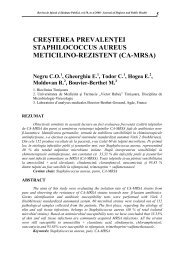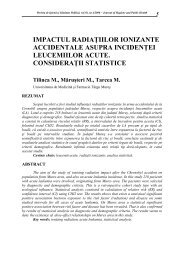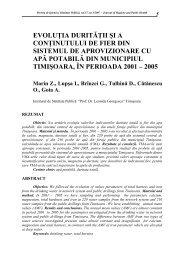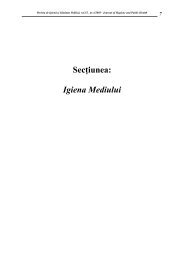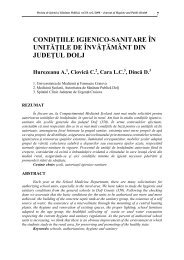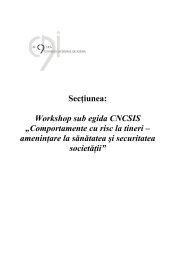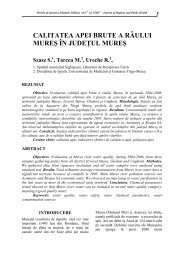poluarea aerului cu pulberi - Revista de Igiena si Sanatate Publica
poluarea aerului cu pulberi - Revista de Igiena si Sanatate Publica
poluarea aerului cu pulberi - Revista de Igiena si Sanatate Publica
You also want an ePaper? Increase the reach of your titles
YUMPU automatically turns print PDFs into web optimized ePapers that Google loves.
8<br />
<strong>Revista</strong> <strong>de</strong> Igienă şi Sănătate Publică, vol.58, nr.3/2008 – Journal of Hygiene and Public Health<br />
markers used: arithmetical mean, median, standard <strong>de</strong>viation and the variability coefficient.<br />
The research of the health status was ma<strong>de</strong> based on a epi<strong>de</strong>miological longitudinal<br />
retrospective study. In every one of the five investigated years it was followed the values of the<br />
arithmetical mean, between 243 t/skm/y in 2002 and 162 t/skm/y in 2005. The values of the<br />
median are lower than the arithmetic mean. The standard <strong>de</strong>viation has values between + 76<br />
and + 28, and the variability coefficient between 37% and 20%. On gathering points, the<br />
highest values are at point nr.2 (industrial platform) in 2002, the value was 325t/sKm/y,<br />
followed by point nr.3 (S.C. CSR-CET) in 2003 with the value of 285 t/sKm/y. The values of<br />
the median are constantly lower than the arithmetic mean. Based on the median values in<br />
gathering points of the study we ma<strong>de</strong> the divi<strong>si</strong>on in to zones of the air pollution. We<br />
observed that a polluted zone contains the gathering points nr.2, 3 and 5 (industrial platform,<br />
C.S. CSR–CET and the gathering center). To establish if it exists a correlation between the<br />
specifically morbidity inci<strong>de</strong>nce and the atmospheric pollution inten<strong>si</strong>ty by <strong>de</strong>po<strong>si</strong>ted<br />
particles, we estimated the Bravais-Pearson correlation coefficient and we obtained + 0,81.<br />
The air pollution effects on the A place population recommends the application of prevention<br />
and control methods.<br />
Keywords: air pollution, <strong>de</strong>po<strong>si</strong>ted particles, specific morbidity<br />
INTRODUCERE<br />
Dis<strong>cu</strong>ţiile pe tema poluării <strong>aerului</strong> se află în<br />
centrul <strong>de</strong>zbaterilor organizaţiilor<br />
internaţionale. Pentru o apreciere corectă a<br />
implicaţiilor poluanţilor atmosferici asupra<br />
stării <strong>de</strong> sănătate a populaţiei expuse s-au<br />
efectuat numeroase studii epi<strong>de</strong>miologice,<br />
care nu au ajuns întot<strong>de</strong>auna la rezultante<br />
conclu<strong>de</strong>nte datorita intervenţiei unui <strong>cu</strong>mul<br />
<strong>de</strong> factori [1]. Argumentarea ştiinţifică a<br />
efectelor negative asupra sănătăţii este<br />
dificilă şi nece<strong>si</strong>tă timp în<strong>de</strong>lungat.<br />
Concluziile unor astfel <strong>de</strong> studii contribuie<br />
la o mai bună <strong>cu</strong>noaştere a problemei, <strong>cu</strong><br />
po<strong>si</strong>bilitatea aplicării măsurilor <strong>de</strong> prevenire<br />
şi combatere [6]. Am întreprins această<br />
cercetare pentru a evi<strong>de</strong>nţia corelaţia dintre<br />
inten<strong>si</strong>tatea poluării <strong>cu</strong> <strong>pulberi</strong> sedimentate<br />
şi acţiunea substanţelor poluante eliminate<br />
<strong>de</strong> sursele industriale asupra stării <strong>de</strong><br />
sănătate a lo<strong>cu</strong>itorilor expuşi.<br />
MATERIAL ŞI METODĂ<br />
Pentru aprecierea dinamicii, naturii şi<br />
inten<strong>si</strong>tăţii poluării <strong>aerului</strong> <strong>cu</strong> <strong>pulberi</strong><br />
sedimentate din municipiul A, în perioada<br />
2002-2006 au fost recoltate, prin metoda<br />
sedimentării, 6720 probe în cinci puncte<br />
prestabilite, atât în zone <strong>cu</strong> surse <strong>de</strong> poluare<br />
industrială, cât şi în zone nepoluate.<br />
Determinarea cantitativă a <strong>pulberi</strong>lor s-a<br />
efectuat conform metodologiei standard, iar<br />
prelucrarea datelor a utilizat indicatori<br />
statistici (media aritmetică, mediana,<br />
<strong>de</strong>viaţia standard şi coeficientul <strong>de</strong><br />
variabilitate). Cercetarea stării <strong>de</strong> sănătate a<br />
populaţiei s-a efectuat pe baza studiului<br />
epi<strong>de</strong>miologic longitudinal retrospectiv<br />
constând în analiza morbidităţii specifice<br />
prin unele afecţiuni po<strong>si</strong>bil a fi <strong>de</strong>terminate<br />
<strong>de</strong> <strong>poluarea</strong> <strong>aerului</strong>, comparativ <strong>cu</strong> un lot<br />
martor dintr-o zonă nepoluată (localitatea<br />
B). Pentru fiecare an cercetat a fost cal<strong>cu</strong>lat<br />
numărul total <strong>de</strong> cazuri, pre<strong>cu</strong>m şi indicele<br />
<strong>de</strong> inci<strong>de</strong>nţă totală. Pentru a stabili o relaţie<br />
cauzală între inten<strong>si</strong>tatea poluării şi<br />
inci<strong>de</strong>nţa morbidităţii am aplicat<br />
coeficientul <strong>de</strong> corelaţie Bravais-Pearson.<br />
REZULTATE ŞI DISCUŢII<br />
1. Dinamica poluării <strong>aerului</strong> <strong>cu</strong> <strong>pulberi</strong><br />
sedimentate, pe ani (Tabelul 1)




